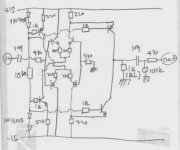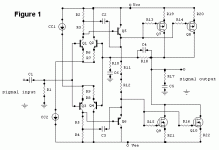Ultima Thule said:
...transimpedance... 🙂
Transimpedance / Transresistance , two words for the same reality ... 🙂
http://www.innovatia.com/Design_Center/Amplifier_Circuits.htm
Transresistance... Google gave 14 100 hits...
Transimpedance.. Google gave 182 000 hits...
Thats why I think only one of them is the right abbreviation! 😉
Cheers Michael
Transimpedance.. Google gave 182 000 hits...
Thats why I think only one of them is the right abbreviation! 😉
Cheers Michael
Ever seen 2 parrots in the Zoo ?
I'm sure some already guessed that it had to be a transconductance amplifier.
Question remains what the reasons are for choosing that approach for the CTC ?
I'm sure some already guessed that it had to be a transconductance amplifier.
Question remains what the reasons are for choosing that approach for the CTC ?
Wow, amazing
350 post, almost 30,000 views, and still don't know what is being talked about
3 blind men comes to the zoo, they wanted to know what an elephant looks like.
No.1 touches the leg. He said, "An elephant is round and big and massive"
No.2 touches the nose. He said, "No, an elephant is long and flexible"
No.3 touches the tail. He said, "How come? An elephant is small and flexible"
350 post, almost 30,000 views, and still don't know what is being talked about
3 blind men comes to the zoo, they wanted to know what an elephant looks like.
No.1 touches the leg. He said, "An elephant is round and big and massive"
No.2 touches the nose. He said, "No, an elephant is long and flexible"
No.3 touches the tail. He said, "How come? An elephant is small and flexible"
There is no mystery here. The transconductance amp is just like the Audible Illusions open loop triode line amp concept: It is simple.
If you think of a single active stage, that has voltage gain, it will always be a transconductance amplifier. We can make line amps with tubes, like this, why not fets?
In order to make an op amp out of this type of design, you have to add some kind of voltage follower, in order to lower the output impedance and to increase the effective gain of the first stage (if possible).
I have always used transconductance amps for my line drives, when practical. They have several other advantages, as well as simplicity.
If you think of a single active stage, that has voltage gain, it will always be a transconductance amplifier. We can make line amps with tubes, like this, why not fets?
In order to make an op amp out of this type of design, you have to add some kind of voltage follower, in order to lower the output impedance and to increase the effective gain of the first stage (if possible).
I have always used transconductance amps for my line drives, when practical. They have several other advantages, as well as simplicity.
john curl said:I have always used transconductance amps for my line drives, when practical. They have several other advantages...
I agree with you, but for me it's rather based on simple listening observations, more than by technical facts, could you develop more technically this point for us.
Transconductance amps are more stable with a difficult load. I made the line driver for the Grateful Dead with this technique. Very difficult load, worked great!. This is because followers tend to ring due to the generation of -R due to phase shift at high frequencies. TA's just slow down, but don't ring very easily.
My designs are also simpler in thru-path than op amps, because they don't have the extra output stage.
My designs are also simpler in thru-path than op amps, because they don't have the extra output stage.
john curl said:There is no mystery here. The transconductance amp is just like the Audible Illusions open loop triode line amp concept: It is simple.
If you think of a single active stage, that has voltage gain, it will always be a transconductance amplifier. We can make line amps with tubes, like this, why not fets?
In order to make an op amp out of this type of design, you have to add some kind of voltage follower, in order to lower the output impedance and to increase the effective gain of the first stage (if possible).
I have always used transconductance amps for my line drives, when practical. They have several other advantages, as well as simplicity.
John,
WRT transconductance for drive, it's funny, maybe we are too
focused on low OP Z figures and as such too easily migrate to a
closed loop circuit or a follower on the back end of an open loop
one to acheive such.
I can see that with the transconductance drive, one advantage is
that into low R loads, the OP voltage just reduces but there is no
increase in distortion, in fact possibly less due to lower voltage
swing.
You have my mind thinking John 🙂
Cheers,
Terry
I have always used transconductance amps for my line drives, when practical. They have several other advantages, as well as simplicity.
Can this be applied to power amps too?
No. This is because of the low impedance of the speaker load.
Is this because non-global feedback? If there is global feedback, transconductance (output in current, coming from Collector/Drain) is possible for power amp?
This one has output from Drains (current output)
Attachments
SY said:Hmmm. What about the Mills and Hawksford work?
Or Nelson's F1 & F2...
dave
Well, do it if you want. It is the problem with second stage gain that I am most concerned about. Also, most here are confused enough.

Also, most here are confused enough.
You are right, Mr. John Curl 😀
If I'm building transconductance type cct, isn't that it can comes only in 2 (diff+VAS) or 1 (folded cascode) only, unlike 3 stages (diff+VAS+output), tranconductance only need up to VAS stage max?
It doesn't bother me any. I have built a few circuits along these lines with variable results, but I attribute that to my being in the learning curve, not to a flaw in the concept. When it works, it works very well indeed.
Higher Zout amps tend to work well with speakers that don't need a lot of damping. Otherwise you need to think in terms of feedback loops that include the driver itself. That adds a layer of complexity that most people don't want to get into because you've got to modify the driver or do something suitably hairy to get the feedback signal. Lotsa trouble for little or no gain.
Grey
Higher Zout amps tend to work well with speakers that don't need a lot of damping. Otherwise you need to think in terms of feedback loops that include the driver itself. That adds a layer of complexity that most people don't want to get into because you've got to modify the driver or do something suitably hairy to get the feedback signal. Lotsa trouble for little or no gain.
Grey
Well, no question that gm amps are for special speakers (e.g., Lowther) and definitely NOT for speakers like John's WATTs. But they CAN be done and there are indeed advantages to doing it that way, not unlike John's application in the preamp.
Again, another dummy question. Is the tranconductance amp "tends" to sound better, because no crossover distortion in the output node, since no emitors in the output node (current comes from collectors)?
An example is Musical Fidelity. Many people said it is sounds good, and it usually uses collector/current output (=tranconductance amp)
PS : SY, why is your avatar looks so scary?
An example is Musical Fidelity. Many people said it is sounds good, and it usually uses collector/current output (=tranconductance amp)
PS : SY, why is your avatar looks so scary?
- Status
- Not open for further replies.
- Home
- Amplifiers
- Solid State
- John Curl's Blowtorch preamplifier

